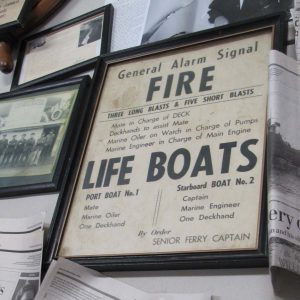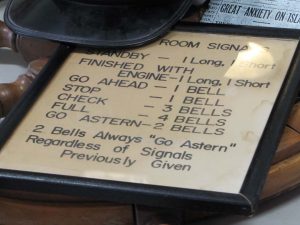November 26, 2011
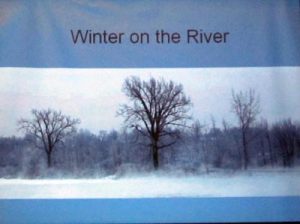 It was a mild day for November, as our speaker Amy Whitehorne, educator at the Brockville Museum, gave her presentation on the St. Lawrence River in winter. Illustrating her talk with interesting historic photographs and sketches, she discussed sports on the river (skating, hockey, curling), Ice Sailing, and Ice Fishing, the one activity that is still ongoing. She pointed out that the previous industrial uses of the river for Logging and Ice Harvesting have both disappeared. And she discussed the river as a border which used to “disappear” in the winter — after all, around Fort Wellington it is less than one mile across to the American side, a distance easily walked or skated.
It was a mild day for November, as our speaker Amy Whitehorne, educator at the Brockville Museum, gave her presentation on the St. Lawrence River in winter. Illustrating her talk with interesting historic photographs and sketches, she discussed sports on the river (skating, hockey, curling), Ice Sailing, and Ice Fishing, the one activity that is still ongoing. She pointed out that the previous industrial uses of the river for Logging and Ice Harvesting have both disappeared. And she discussed the river as a border which used to “disappear” in the winter — after all, around Fort Wellington it is less than one mile across to the American side, a distance easily walked or skated.
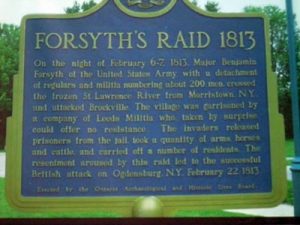 It was therefore simple for American troops to “raid” Brockville during the War of 1812: they just walked across the ice! Not much damage was done, except that a few residents were temporarily imprisoned and some supplies taken. However, Red George Macdonnell, in charge of the garrison at Fort Wellington, was very irritated and wanted to take revenge by raiding the American side. The Lieutenant-Governor happened to be in residence at Prescott, and he didn’t want Macdonnell to attack but said he could at least drill his troops on the ice between Prescott and Ogdensburg in order to “intimidate” the Americans. That’s just what Macdonnell did, but every little while he edged the troop of combined British soldiers and Upper Canadian militiamen closer to the American side. Eventually they were just off the New York shore, and suddenly attacked Ogdensburg. You can read an excellent article about this at www.1000islands.com/ogdensburg/war_1812/.
It was therefore simple for American troops to “raid” Brockville during the War of 1812: they just walked across the ice! Not much damage was done, except that a few residents were temporarily imprisoned and some supplies taken. However, Red George Macdonnell, in charge of the garrison at Fort Wellington, was very irritated and wanted to take revenge by raiding the American side. The Lieutenant-Governor happened to be in residence at Prescott, and he didn’t want Macdonnell to attack but said he could at least drill his troops on the ice between Prescott and Ogdensburg in order to “intimidate” the Americans. That’s just what Macdonnell did, but every little while he edged the troop of combined British soldiers and Upper Canadian militiamen closer to the American side. Eventually they were just off the New York shore, and suddenly attacked Ogdensburg. You can read an excellent article about this at www.1000islands.com/ogdensburg/war_1812/.
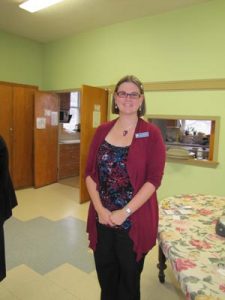 Amy Whitehorne invites everyone to visit the Brockville Museum, housed in an 1830s house at 5 Henry Street in Brockville.
Amy Whitehorne invites everyone to visit the Brockville Museum, housed in an 1830s house at 5 Henry Street in Brockville.
September 24, 2011
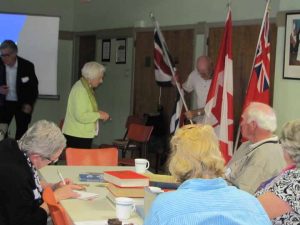 There’s always a lot going on at our meetings — why not visit one and see for yourself?
There’s always a lot going on at our meetings — why not visit one and see for yourself?
As our speaker Mark gets set up (rear left), Past President Lin Good, filling in for President Dean Taylor, watches as the Loyalist flag is placed in its stand. Meanwhile, three visitors in the foreground are busy making notes from some books in our reference library, adding to their knowledge of their Loyalist ancestors.
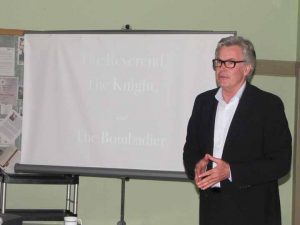 Our speaker was Mark Jodoin, a historian from Ottawa. Mark had titled his talk “The Reverend, the Knight and the Bombardier” — referring to three members of the Stuart family. But before discussing them, Mark summarized some of the other stories in his book Shadow Soldiers of the American Revolution: Loyalist Tales from New York to Canada (Charleston and London: History Press, 2009, ISBN 978.1.59629.726.5). Mark spoke briefly about Joel Stone, Edward Jessup, Henry Simmons, George Smyth, Justus Sherwood, John Deserontyon and Molly Brant.
Our speaker was Mark Jodoin, a historian from Ottawa. Mark had titled his talk “The Reverend, the Knight and the Bombardier” — referring to three members of the Stuart family. But before discussing them, Mark summarized some of the other stories in his book Shadow Soldiers of the American Revolution: Loyalist Tales from New York to Canada (Charleston and London: History Press, 2009, ISBN 978.1.59629.726.5). Mark spoke briefly about Joel Stone, Edward Jessup, Henry Simmons, George Smyth, Justus Sherwood, John Deserontyon and Molly Brant.
In 1730 Andrew Stuart emigrated from Ulster, Ireland to Paxton County, New York. He married a daughter of Robert Dinwoodie, governor of Virginia Colony. One son was Jeb Stuart, well known in the US as a cavalry officer. Another was John, born 1740, educated in Philadelphia and London. In 1770, after obtaining a Doctor of Divinity, he was sent to Fort Hunter, near the holdings of Sir William Johnson. As most Loyalists know, he came to Canada with the Loyalists, first to Montreal and then settling in Kingston where he established St. George’s Church. Rev. John married Jane Okill (a distant connection to Camilla, the present Duchess of Cornwall). Their great-grandson, Sir Campbell Stuart, is the Knight mentioned by Mark: he moved in the highest social and financial circles, eventually becoming managing director of the Times of London. Campbell’s nephew, Okill Stuart, is a member of our branch and a war hero in his own right from his service in World War II. Mark is presently working on a new book on the Stuart family.
Mark pointed out that some of John Stuart’s artifacts, such as a tankard which was a wedding gift from Jane Okill’s parents, as well as books and other items, may be seen in the Stuart Room at St. George’s Cathedral, Kingston.
June 1, 2011
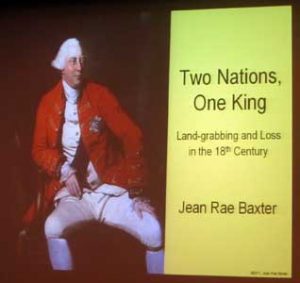 Our annual dinner meeting was held at the Donald Gordon Centre, Union Street, with about 50 persons present.
Our annual dinner meeting was held at the Donald Gordon Centre, Union Street, with about 50 persons present.
After a delicious dinner and animated conversation around the various tables, member Terry Hicks introduced our speaker for the evening, Jean Rae Baxter. Jean is a retired educator who has written several books, including both crime fiction for adults and historical fiction for young teens. Her novel, The Way Lies North (2007) is the story of a Loyalist girl during the period of the American Revolution.
Jean titled her talk “Two Nations, One King: Land-grabbing and Loss in the 18th Century”. She outlined the relationship of native Americans to Queen Anne, who met four native “Kings” who were taken to England to meet her — 3 Mohawks, one Mohican. She had their portraits painted, and the paintings are now in Library and Archives Canada.
Queen Anne, a devout Protestant, was concerned for the spiritual welfare of the natives, and paid for the erection of a chapel at Fort Hunter (Scoharie) in 1711. The set of communion silver she sent to the natives was buried for safety during the Revolution. It was dug up during the war, and when brought to Canada, half was placed in the church at Deseronto and half at Brantford, Ontario.
Jean then outlined how two different groups of natives were treated by the British government. Those in the Southern Department, under commissioners John Stuart (not the Loyalist minister) and later Alexander Cameron, sold off land belonging to the native inhabitants to land speculators. The Henderson Purchase in 1775 was the largest private land purchase in the history of what became the United States: 20 million acres were sold by this agent of the Crown, for £2,000 and 6 wagonloads of trade goods paid to the Cherokees (who were later displaced from the southeastern states and forced to walk to Oklahoma Territory in the winter of 1838, a trek known as the “Trail of Tears”). Their leader Dragging Canoe was not strong enough to resist, and the Patriots felt they had supported the British too loyally during the Revolution.
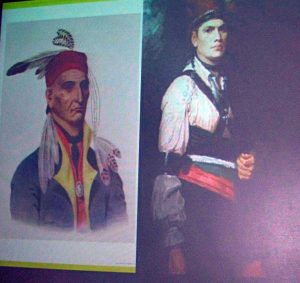 Dragging Canoe (left) and Joseph Brant
Dragging Canoe (left) and Joseph Brant
The Mohawks, meanwhile, fared better in the Northern Department under commissioner William Johnson, and their own strong leaders. White and native worlds merged at Johnson Hall, finding common ground in religion since many Mohawks converted to Christianity (vs. southern natives who did not). Although natives and their lands were not mentioned in the Treaty of Paris which ended the Revolutionary War, Joseph Brant formed a loose federation with other chiefs and was able to pressure the British government. The result was that Frederick Haldimand was directed to compensate the Mohawks for loss of their lands, as he was doing for white Loyalists.
You can read about this in more detail in Jean Rae Baxter’s second book set during the American Revolution, Broken Trail. For further details, see Jean’s web site www.jeanraebaxter.ca.
March 26, 2011
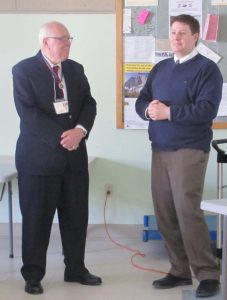 After a delightful sandwich lunch and conversation, President Dean Taylor began the meeting with our speaker, and followed the presentation with the business meeting.
After a delightful sandwich lunch and conversation, President Dean Taylor began the meeting with our speaker, and followed the presentation with the business meeting.
Craig Boals is the Director of Operations at Cataraqui Cemetery. Cataraqui was incorporated in 1850 by the Government of the United Canadas. It can be defined as a rural cemetery (making use of the natural features such as rolling hills and streams, as well as meeting the traditional understanding of rural as being outside of town). The original directors placed it beyond the City of Kingston because there was concern about bringing diseased bodies into the city confines.
Cataraqui is also a non-denominational public cemetery, a not-for-profit cemetery, an historic cemetery (it is hoped soon to obtain designation as a National Historic Site), and an active cemetery.
Craig pointed out that several ceremonies are held annually by outside groups, to honour those buried in Cataraqui Cemetery. The Correctional Service of Canada holds a memorial service at the site of Harry Traill’s grave. Harry Traill, son of early Canadian writer Catherine Parr Traill, was the first prison officer in Canada killed on active duty (1870).
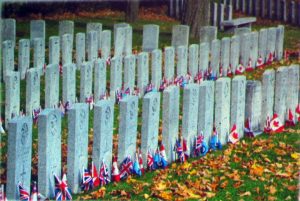 The 1st Canadian Signals Regiment hold a service annually at the grave of Carruthers, founder of the Signals Regiment. And there is an annual Remembrance Service held on November 10th in the Military Plot. Canadian flags are placed on the graves by local schoolchildren.
The 1st Canadian Signals Regiment hold a service annually at the grave of Carruthers, founder of the Signals Regiment. And there is an annual Remembrance Service held on November 10th in the Military Plot. Canadian flags are placed on the graves by local schoolchildren.
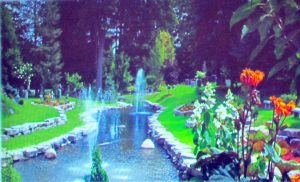
In the 1880s, Superintendent David Nicol began consciously turning Cataraqui into a garden cemetery, modelled after Mount Auburn Cemetery near Boston. In particular he introduced a wide variety of special trees and plants. The white hydrangea tree (at left rear in the photo to the right) became the “signature” tree of the cemetery.
Superintendent Nicol scattered fountains, statues and giant urns around the cemetery. Unfortunately a number have been stolen over the years, but those remaining add delight to the cemetery.
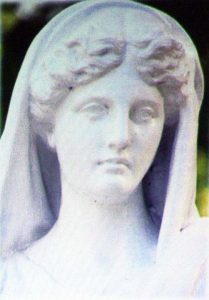
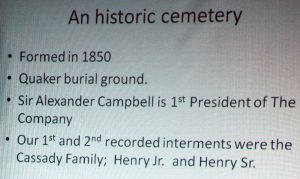 Mr. Boals invited everyone to visit Cataraqui Cemetery often, to enjoy its history and its beauty.
Mr. Boals invited everyone to visit Cataraqui Cemetery often, to enjoy its history and its beauty.
Researchers may want to consult transcriptions of the earliest burial records and of monuments produced by the Kingston Branch, Ontario Genealogical Society, keeping in mind that some persons buried at Cataraqui have no memorial above ground but may be found in the cemetery records. Staff at the Cemetery Office can help visitors locate specific gravesites.
photos Nancy Cutway UE
January 22, 2011
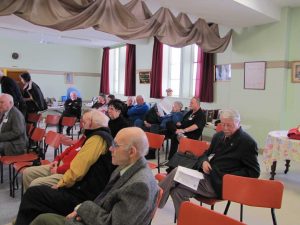 We started 2011 with a delicious potluck lunch, just the thing to warm our hearts and tummies on a cold winter day. Then we cleared the tables and rearranged the chairs for the meeting.
We started 2011 with a delicious potluck lunch, just the thing to warm our hearts and tummies on a cold winter day. Then we cleared the tables and rearranged the chairs for the meeting.
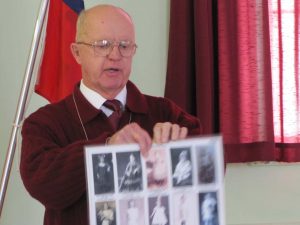 Lynn John Bell brought a “Show and Tell” item after the brief business meeting. Lynn reminded us that he’s been collecting old photographs (mostly family, but some from the neighbourhood) and assembling them according to various themes, in this case pictures of children. He laminates the resulting pages, which can make placemats. A great gift idea!
Lynn John Bell brought a “Show and Tell” item after the brief business meeting. Lynn reminded us that he’s been collecting old photographs (mostly family, but some from the neighbourhood) and assembling them according to various themes, in this case pictures of children. He laminates the resulting pages, which can make placemats. A great gift idea!
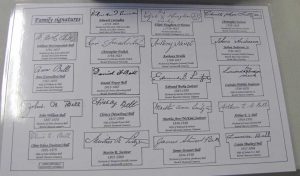
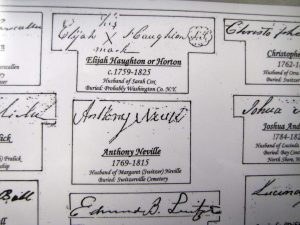 Lynn’s latest collection is the signatures of his ancestors, found on wills, land records or other documents. He has added information on the person’s spouse, burial place, etc. He’s included the marks of those who could not sign, since the very fact that they could not do so provides part of the story of that individual.
Lynn’s latest collection is the signatures of his ancestors, found on wills, land records or other documents. He has added information on the person’s spouse, burial place, etc. He’s included the marks of those who could not sign, since the very fact that they could not do so provides part of the story of that individual.
Right: Close-up of the Family Signatures sheet.
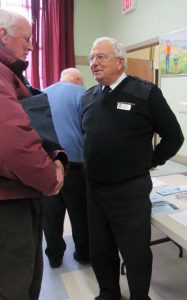
Speaker Brian Johnson, senior captain on the ferry Wolfe Islander III, presented a most interesting history of the ferries that plied between Kingston and Wolfe Island. Looking at today’s 55-car ferry, you would not realize that some Loyalists arrived overland at the northern border of New York state — Lake Ontario and the St. Lawrence River — and needed to load a wagon, a horse, perhaps some cattle or oxen and probably a few chickens, to say nothing of their family members, onto a wooden ferry that would sail them around Wolfe Island, or else take them to the south side of the Island. From there they would have to trudge across the island to the north side, and take another ferry to Kingston. Captain Johnson brought an impressive display of documents, memorabilia and photos, and showed many others via computer.
Members continued to ask questions and study the display long after his talk. A most enjoyable afternoon. Watch for announcement of the appearance of Brian Johnson’s forthcoming book, Ferry Stories from Wolfe Island.
